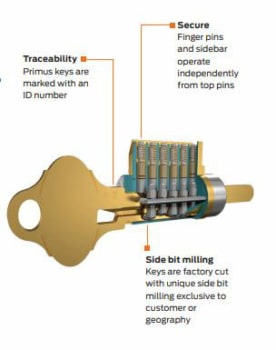Organizations Facing Large Rekey Projects
By Ryan Kaullen, Field Services Manager at Kenton Brothers
 In a company or organization, it’s up to the organizational leaders to make sure that their people, property and possessions are kept safe and secure. Part of the strategy relies on the keying method used in the building(s). Kenton Brothers has been helping companies with large rekey projects since 1897.
In a company or organization, it’s up to the organizational leaders to make sure that their people, property and possessions are kept safe and secure. Part of the strategy relies on the keying method used in the building(s). Kenton Brothers has been helping companies with large rekey projects since 1897.
So where does a company start when it comes to large rekey projects? What details are needed? How can they secure buildings and maintain control when handing out keys? Are there different levels of restricted cylinders to help secure the facility? All of these questions and more will be answered as we dive into large rekey projects.
The Rekey Plan
Everything starts with a plan, and it should be a plan that has the end goal in mind. Part of a rekey plan is an evaluation of many things including who should have access, what type of keys should be issued to employees and which keys should not, how should the key system be structured, how do you mitigate liability if a key is lost, how can keys be organized and how do we track who we issued keys to? What level of restriction should you have on the keys and cylinders? Will existing door hardware work or does it need to be switched out?
 Setting up a master key system for one large facility, a campus environment with multiple buildings, or even a scenario where there are different buildings across the country can all be handled by setting up a master key system that allows for growth/expansion and the flexibility within that system to do so.
Setting up a master key system for one large facility, a campus environment with multiple buildings, or even a scenario where there are different buildings across the country can all be handled by setting up a master key system that allows for growth/expansion and the flexibility within that system to do so.
A site survey(s) should be done by the company hired for the large rekey project. (Hopefully, that would be our team at Kenton Brothers!) From there, several meetings should occur to discuss the set up of the master key system, discuss the level of security you want with the keys/cylinders and set expectations for the rekey itself.
Organization of the physical keys, cores and additional information can come in many forms, but the three most common we see are:
1) The customer purchases a key management software system. (We have a great recommendation if you are looking…) and manages it themselves
2) Kenton Brothers manages the key system through our software and we handle any change requests
3) The keying system is a factory-maintained system (which comes with its own advantages and disadvantages.)
Once the planning stages have been completed, you will move on to the next step of the process… waiting for parts.
The Waiting Game
 So now that a master key system has been agreed upon, pricing approved, and materials are on order, what are the next steps? At this point, you will have chosen the path of how you will manage your key system; either internally or through a company such as Kenton Brothers. 80% of the effectiveness of the new keying system is in maintaining control of the keys!
So now that a master key system has been agreed upon, pricing approved, and materials are on order, what are the next steps? At this point, you will have chosen the path of how you will manage your key system; either internally or through a company such as Kenton Brothers. 80% of the effectiveness of the new keying system is in maintaining control of the keys!
One of the big things to prepare for is communication to the employees and staff who will be issued new keys. You will want to communicate that this is coming, when it’s happening, set up strict instructions on checking out keys, reporting lost keys and what to do if you find a key laying around.
From the start, it’s important that clear expectations are set because keys are such an integral part of your security plan. You will also be in weekly or bi-weekly contact with a Project Manager dedicated to your project for planning, when the product will arrive, any last-minute questions, and any pre-install meetings before the installation begins.
The Install
 The install itself will begin with a Project Manager (PM) introducing you to the technicians who will be working on the project. The PM makes sure that once on site, the techs have clear expectations of their daily goals, know the location of material being stored onsite (if applicable), and any other project related questions they might have. Then the work begins!
The install itself will begin with a Project Manager (PM) introducing you to the technicians who will be working on the project. The PM makes sure that once on site, the techs have clear expectations of their daily goals, know the location of material being stored onsite (if applicable), and any other project related questions they might have. Then the work begins!
The PM is the point of contact for the project. They need to keep everyone up to date, share milestones that have been completed and work through punch list items as the project progresses. Once the project is complete, there will be a final walk through. When the project is deemed complete as compared to the scope of work, a warranty form should be completed and signed.
Once the project is finished, there will be several documents that need to be delivered by the PM for records. Those documents include the following: A fully completed warranty activation form, any maps/plans used during the project fully marked up to show how things were keyed or installed, keying records if requested, and any other documents deemed necessary for the project.
Recap
Large Rekey Projects can be stressful, take time and require a lot of planning. That said, the end result is worth it.
You now have complete key control over the building(s) that you oversee. You have taken a major step to protect the property, possessions, and people who work/live within the buildings, and you have a plan moving forward that is sustainable and mitigates liability.
If your organization is considering a rekey project and you don’t have a company you trust helping you, please give us a call. We’ve helped thousands of companies over the years with large rekey projects, allowing them to take back control of their security. Get back your peace of mind!




Leave a Reply
Want to join the discussion?Feel free to contribute!